FRIDAY 13th : Le Grand Cirque
:: On friday march 13th, at
La Comète 347 in Paris, you may attend the first ever
SIMULTANEOUS EAI
concert, curated by Jean Bordé. That evening in three different
corners of La Comète three different EAI-groups
(La Brocante
Sonore [Belgium/France], DIKTAT
[Paris/Berlin], and Nozal
Cube [France]) will perform at the same time ... Be
there at 20h30 ...
[ report
]
PETIT PARIS: das kleine à PARIS :: On saturday march 14th Radio Aligre FM/SoP and Ana-R present the first Parisian edition of das kleine fieldrecordings festival, the renowned running festival organized and curated by Rinus van Alebeek, dedicated to the divers ways in which artists make use of fieldrecordings: the recorded sounds of our environment ... Place to be: Espace Radio Aligre, 42 rue de Montreuil, Paris XI. Rinus himself will be the event's maître de cérémonies... That's from 17h till 21h ... [ report ]
The Meaning of Life [i]
march 04, 2009.
When after sunset I walk the short distance from the metro to my house,
far away, on the westside of the city, I can see the Eiffel tower mistaking
itself for a lighthouse, with its searchlight restlessly lashing the evening
sky. 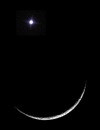 Not very long ago the tower's light rhythmically crossed the nightly view
that I reproduced in the image to the left. It was a view that I found so
striking that I held still for a while to watch it. The fine rim of
moon shone low, just a bit over the city skyline. Seeing it made me
feel as if I were, well, ... elsewhere ... were it not for the
so familiar sound of the traffic that kept rushing beside me along the avenue.
And there was this enormous star glittering & shining in a
spot placed symmetrically above the moon's circle. But was it a
star? I wondered. Could it be a satellite? Or maybe it was an airplane?
But then all the time that I stood still and watched, it did not move ...
It was very strange, it seemed so big ... much too big and far
too bright for a star shining in a city sky.
Not very long ago the tower's light rhythmically crossed the nightly view
that I reproduced in the image to the left. It was a view that I found so
striking that I held still for a while to watch it. The fine rim of
moon shone low, just a bit over the city skyline. Seeing it made me
feel as if I were, well, ... elsewhere ... were it not for the
so familiar sound of the traffic that kept rushing beside me along the avenue.
And there was this enormous star glittering & shining in a
spot placed symmetrically above the moon's circle. But was it a
star? I wondered. Could it be a satellite? Or maybe it was an airplane?
But then all the time that I stood still and watched, it did not move ...
It was very strange, it seemed so big ... much too big and far
too bright for a star shining in a city sky.
Then I went inside.
About an hour later, when I went out again to buy a beer, there was neither
moon, nor big star to be seen.
The Eiffel tower went on pretending to be a lighthouse.
...
I was one of the tens of thousands that over the weekend of february 21st shuffled through the Grand Palais in Paris, looking (or gazing, that will be the more appropriate verb) at the treasures gathered by fashion icon Yves Saint Laurent and his partner Pierre Bergé over a period of near to half a century. Following the couturier´s demise in june 2008, Bergé decided to do away with the joint collection. Almost all of it got scattered worldwide by auction house Christie´s in the course of a three day bid and sell event that created something of a pre-spring fever in the curious parallel world of dealers and collectors of art and invaluable objects. The event assembled, in that same Grand Palais early last week, a substantial number of the individuals that together own a part of the earth´s pecuniary capital that seems oblivious to crashes and crises. Many of them were there, either in person or through one of the 100 dedicated telephone lines, installed for the occasion.
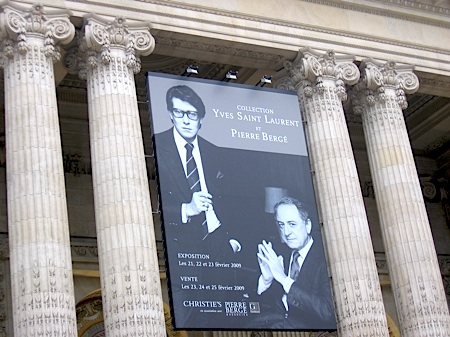
I went to have a look, but admittedly not because of a hunger for culture that I needed to still. I went not even out of plain curiosity. I was there only because I could walk right in and skip the hundreds of meters long line of patient people, many of them reading, that had to cue up, at times for as long as between four and six hours, before finally they were allowed to enter. That I could walk right in was not because of some special merit, and even less so thanks to my bank account. Nevertheless, it was like that.
It was an interesting family outing.
For the two-and-a-half viewing days preceding the auction (which began on the evening of monday february 23rd) the huge inner hall of the Grand Palais had been divided into two groups of each seven 'rooms', in order to present the more than 700 items of the auction's catalogue in a context reminiscent of the disposition of the works and objects in the intimacy of the collectors' homes. Some of the rooms of Yves Saint-Laurent's apartment on the rue de Babylone had to that end been more or less reconstructed; which may be sort of a cute idea in principle, but not when - as in the Salon Babylone - you are herdlike being urged along its walls, by a large number of earphoned security men, one of whom moreover is shouting "No pictures, please!", every thirty seconds or so.
It was too much, and also inside soon I started skipping most of the lines.
In fact I spent much of my time looking from a little distance at all those
gazing shufflers, while attempting to shrug off the shivers
that the looped-to-muzak tunes that were playing kept sending down my spine. These
were so tastelessly average that it almost made me wonder whether this was not a
tasteless-on-purpose ... It formed a curious contrast with the so refined, and very expensive, taste
reflected in the exposed art and objects. It indeed (though
probably unwantingly so) made it crystal clear that at the end of the line all of it, at least as far as Christie's is concerned, was merely merchandise.
Every now and then a Christie's employee came snatching some painting or
object from its spot in order to show it to some verified potential buyer;
together with the interested party it was then taken into a quiet corner
for close up inspection, after which the lot was put back into
its spot. That, and the fact that on the little printed cards attached next
to each of the items prominently figured the range of the estimated selling
price. Be assured that during these two days and a half the thus exposed
numbers were studied with at least as much interest
and looked at least as often and as carefully as at the goods
they were an attribute of ... (Someone must
have done already sometime somewhere an exhibition with all the works removed,
and only prices left, no? ...)
One entered the public viewing of the collection in the Salon Apollon,
where I had a lot of fun contemplating a series of antique
male torsos together with my daughter. All were castrated by the ages, and wore a little screw where
used to be their prick. I found it surprising to find that actually much of the public seemed to
be but vaguely interested in the collection of paintings. The bulk of the
crowd was swarming around the many objects, the statuettes
and the furniture, all of which had a (collector's) value that
went fascinatingly far beyond my comprehension. Take for example Eileen
Gray's Dragons Armchair (see the picture), which was put on
sale with an estimated selling price between 2 and 3 million euros. It was
bought on tuesday february 24th by Parisian galeriste Cheska
Vallois, who put down about ten times as much for this fauteuil
(made sometime in the late 1910's), near to 22 million euros.
I found it surprising to find that actually much of the public seemed to
be but vaguely interested in the collection of paintings. The bulk of the
crowd was swarming around the many objects, the statuettes
and the furniture, all of which had a (collector's) value that
went fascinatingly far beyond my comprehension. Take for example Eileen
Gray's Dragons Armchair (see the picture), which was put on
sale with an estimated selling price between 2 and 3 million euros. It was
bought on tuesday february 24th by Parisian galeriste Cheska
Vallois, who put down about ten times as much for this fauteuil
(made sometime in the late 1910's), near to 22 million euros.
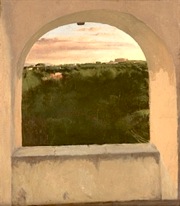
|
It was possible indeed to have a long quiet look at most of the paintings, without being pushed around too much by crowds.
I much liked the very first lot in the series, the Paysage d'Italie vu par une lucarne ('Italian landscape seen through an arch') by Edgar Degas, a small oil painting on paper laid down on canvas, made in september 1856, probably in the attic of the country house of his grandfather. It eventually was sold for 'only' €457.000, one of the few works that still seemed relatively affordable :-) ...
This was definitely not the case for the three Compositions
in the Piet
Mondrian collection of Saint Laurent and Bergé: a monochrome Composition
with grid 2, from 1918; the Composition I painted in 1920;
and the Composition with blue, red, yellow and black from 1922,
one of his first fully Neo-Plasticist paintings.
Below's a picture of the Composition with blue, red, yellow and black
(which Mondrian sold to Helene
Kröller-Müller in 1922, and which Saint Laurent and Bergé acquired
from the Parisian Tarica gallery in 1978); next to it there's a picture of Yves
Saint Laurent's 'Mondrian'
day dress, from 1965:
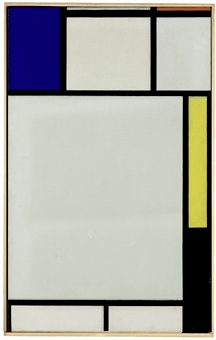 |
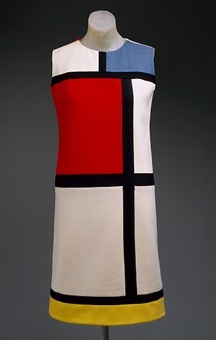 |
All three of the neo-plasticist paintings on view in the Grand Palais came in the original artist's frame, which are of course an integral part of the work. The thin pieces of wood, some somewhat splintered in the corners, add quite a bit to the impression of a relentless aging that I find so typical for these paintings: each time I see Mondrian's neo-plasticist paintings (the originals I mean, as opposed to just their picture) I'm amazed by how old they look, how frail, and how worn. This is evidently not because they have been thrown around, were stocked in bad conditions or otherwise treated badly. It is what they are, and the way in which they were made, which makes them extremely sensitive to the passing of time, far more than any other paintings I know. As (ad lib reproducible) images they will always remain the theorems (pure idea and construct) that they were at their time of conception. But the (un-reproducible) original Mondrian neo-plasticist paintings are fading theorems, constructs that time is slowly but without mercy taking apart. This makes them almost ... human ... and lends them a profound melancholic beauty which, all things considered, actually might well be worth paying 21 and a half million euros for.
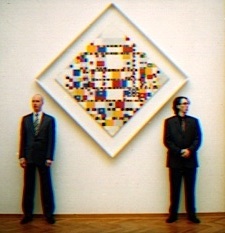 |
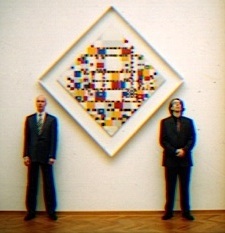 |
Hollandse Meesters (Dutch Masters) in the Gemeentemuseum, The Hague (the Netherlands), on april 10th, 2001. Left to right: Ronald Heiloo, Piet Mondrian ('Victory Boogie Woogie') and Har$. (Photos © Willem Langeveld, Amsterdam) | |
Asked in an interview with the french newspaper Le Monde to sketch the profile of the average buyer at an auction like this, Claude Aguttes explains that the bulk consists in a group of some 200 individuals that are among those possessing the biggest fortunes of our planet. "They always come to buy at these auctions," he says, "though most of them will remain anonymous. Their budget in general is absolutely without limit. Though they often buy purely on instinct, they run little or no risk, as they are investing in works and objects that are so extremely rare that they simple can not loose their value."
It
is thus maybe even thanks to current crashes and crises in today's global economies that at
Christie's sale of the Saint Laurent / Bergé collection buyers together spent
over 350 million euros ( * ). 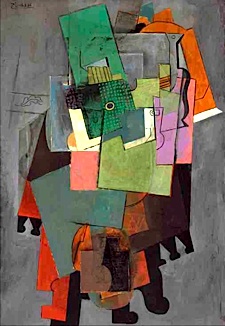
Apart
from the ongoing row
over two Chinese relics (claimed by the Chinese government, then bought
by a 'mystery buyer from China' for over 31 million euros, who now refuses
to pay for them), arguably the biggest surprise was the 'not sold' of Pablo Picasso's
Instruments de musique sur un guéridon ('Musical Instruments on a Table'), painted around 1914-1915. After early
records on monday's auction for among others a Brancusi, Duchamp and Mondrian (all of which went for several times
their estimated value) nobody wanted lot #50, a Picasso that entered the auction with an estimated selling price between
25 and 30 million euros. The bidding did not get past a 'mere' 21 million, so Pierre Bergé just kept the thing.
I actually can agree with all these non-buyers. But then I also do find
that despite his undeniable importance, Picasso often is greatly overrated. In
the Grand Palais I found the "Musical Instruments on a Table" particularly
gloomy looking, and it didn't inspire me to much more than the thought that
it strongly reminded me of our 1960s interior in the small house
in Pottenberg, the post-war suburb of Maastricht where I spent part of my
early youth.
The un-sold Picasso maybe also indicates that Aguttes - as I very much hope - is not entirely right when he says that most of the buyers are actually driven by some sort of a 'buying bulimia'. And that though the bulimic capitalist buying priceless works of art merely to secure the family capital and to show off for his bulimic capitalist friends surely will exist, most will be well aware that they are buying human time and tales; and that besides the things that are, they acquire the things as they once were and then became.
Below there's a picture of Alexander Calder's beautiful mechanical mobile Dancers and Sphere. It caught me by surprise when I chanced upon it that sunday in the Grand Palais. I first saw it under an angle that made it look an awful lot like a rendering of the moon-and-star constellation that I sketched at the beginning of this story ... The object was conceived of and made in 1936, as part of a series of 'ballet-objects'. It is an interesting exercise in spatial imagination to look at the picture and try to imagine what it will look like from different angles, when set into motion.
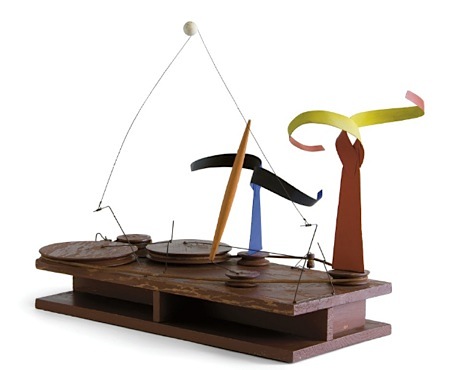
Do you see how it looks an awful lot like a Mondrian painting set in motion?
That is no coincidence. It was a visit to Mondrian's studio in the early 1930s that inspired the abstract turn that Calder's work
was to take, and he is quoted as stating that he intended to make the elements as they appear in Mondrian's work 'oscillate in different
directions and amplitudes' ...
It was, btw, Marcel Duchamp who baptized Calder's early wind-driven sculptures from 1932: 'mobiles'
... Which then finally brings us to the one object that for me was by far the most telling inclusion in Yves Saint Laurent's collection.
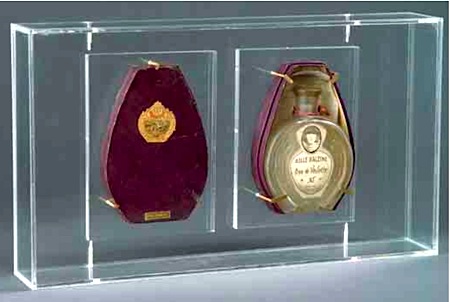
You know that Kurt smelt like teen spirit. For similar reasons (though it admittedly makes for a far less brilliant song title) I smelt like opium. Which is the line of perfume that Yves Saint Laurent to great success marketed since 1977.
So many of the girls I knew that swore by it ...
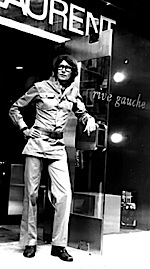 Yves
Saint Laurent and Pierre Bergé acquired 'Belle Haleine - Eau de Voilette',
an 'assisted ready-made' that Marcel Duchamp made together with Man Ray
in the spring of 1921, from Parisian gallery Tarica in 1990. It was made
from a bottle of the popular Parisian Rigaud Company's 'Un Air Embaumé'-perfume,
that Duchamp had bought in Paris, sometime 1919s.
Yves
Saint Laurent and Pierre Bergé acquired 'Belle Haleine - Eau de Voilette',
an 'assisted ready-made' that Marcel Duchamp made together with Man Ray
in the spring of 1921, from Parisian gallery Tarica in 1990. It was made
from a bottle of the popular Parisian Rigaud Company's 'Un Air Embaumé'-perfume,
that Duchamp had bought in Paris, sometime 1919s.
...
Like Yves Saint Laurent gave the world its opium, it was Duchamp's
female alter-ego Rrose
Sélavy that gave the art world 'Belle Haleine'. On monday february 23rd the 1921 ready-made was bought for almost
9 million euros, 8 to 9 times the
estimation, by
Franck Giraud, a french art broker from New York. A relatively small price still, I'd say, for a work, that is not only emblematic for dada,
but also for the life and times of the modified perfume bottle's former owner.
For "Rrose Sélavy", would that not also have been
Yves Saint Laurent's
motto? ... I even dare say that, as a matter of fact, he looked like her, an awful lot ...
notes __ ::
(*) The money raised will be used for the funding
of AIDS research. [ ^ ]
tags: Paris, art, Yves Saint Laurent, Pierre Bergé, Piet Mondrian, Marcel Duchamp, Pablo Picasso, Alexander Calder, teen spirit, opium
# .297.
smub.it | del.icio.us | Digg it! | reddit | StumbleUpon
comments for The Meaning of Life [i] ::
|
Comments are disabled |